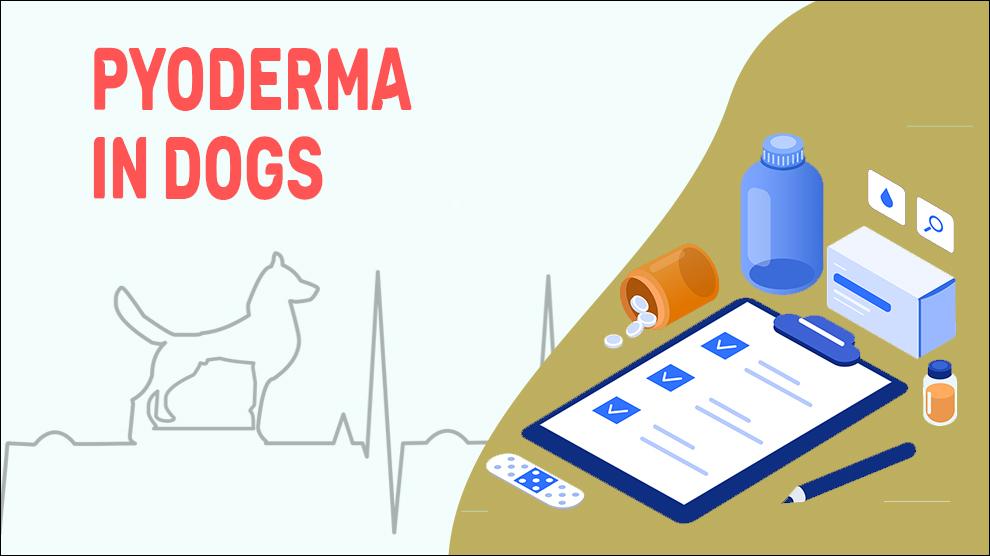What Is Pyoderma In Dogs?
One of the most common canine skin disorders is Pyoderma. Pyoderma is considered to be a cutaneous pyogenic infection that means ‘pus in the skin’. Excessive scaling, Bald patches, scabbing, and welts around hairs are common signs of pyoderma. Pyoderma crops up all through the dog’s body, but the most common locations are the facial folds, lip folds, neck folds, abdomen, feet, etc.
Pyoderma results from compromised local defense mechanisms, which paves way for secondary bacterial invasion of the skin. Allergic dermatitis and endocrine diseases are the most common underlying skin diseases but there are also several other skin diseases that can also predispose to pyoderma.
Coagulase-positive Staphylococcus pseudintermedius is the most common cause of pyoderma in dogs. This was earlier misdiagnosed as Staphylococcus intermedius. S. pseudintermedius is most commonly found in the mucosal sites (i.e. nares and anus).
Other pathogens that cause pyoderma are Coagulase-negative staphylococci, α-hemolytic streptococci, Micrococcus spp., Acinetobacter spp., aerobic coryneforms, Staphylococcus schleiferi, Staphylococcus aureus, Proteus spp., Escherichia coli, and Pseudomonas aeruginosa.
Symptoms Of Pyoderma In Dogs
- Dry Scaly Skin
- Blood Or Pus On Skin
- Crusted Scabs Or Oozing Sores
- Malodorous Odor In The Reddened Area
- Rubbing, Scratching, Or Pawing At The Affected Area
- Patchy Or Inconsistent Hair Loss
- Sensitivity To Touch
- Self Trauma
Treatment Options For Pyoderma In Dogs
- Anti-inflammatories: Topical, oral or injectable corticosteroids. Synotic (Zoetis),fluocinolone,etc.
- Allergy therapy: Injectable Cytopoint or Apoquel may be prescribed or a hypoallergenic therapeutic diet can be tried (food elimination trial).
- Antihistamines: Cyproheptadine, Chlorpheniramine, Cetirizine, Clemastine, Hydroxyzine, and Trimeprazine.
- Topical adulticides: Fipronil, imidacloprid, metaflumizone, selamectin, indoxacarb.
- Oral adulticides: Nitenpyram, spinosad.
- Corticosteroids and Immunosuppressive Agents: Cyclosporine (Atopica), Cortisone (dexamethasone, prednisone, prednisolone), Azathioprine, leflunomide, and mycophenolate mofetil.
- Antipruritic drugs: Pentoxifylline (Trental), Misoprostol (CytotecR), Zileuton.
- Antibiotics and Antifungal Medications: These are required to treat secondary infections.
Home Remedies For Pyoderma In Dogs
- For the chewy or scratchy dogs, Consider using an inflatable/ Elizabethan collar
- Use pet-friendly anti microbial wipes and keep the dog clean and dry
- Clean food and water bowls daily
- Use ointments/Creams to ease itching & irritation
- Use Cold compresses when needed
How To Prevent Pyoderma In Dogs?
- The best way of Pyoderma prevention is to address skin inflammation and itching at its initial stages.
- Consult with your veterinarian dermatologist for hypoallergenic vaccinations.
- If your dog has a flea allergy, the best method of control is avoidance.
- Use medicated wipes containing a skin disinfectant; keep the fur/jowls/mouth clean which is usually twice a day. Always dry the area thoroughly after cleaning.
- The dog's skin folds should be cleaned at least twice weekly with clean paper napkins (or cotton washcloths), veterinary formula shampoo (e.g. vetMD medicated shampoo), spray, wipes, and skin cleanser.
- Those you are unable to bathe their dog often, they’ll have to spot clean the affected areas daily to remove trapped food and moisture.
Affected Dog Breeds Of Pyoderma
Bulldog, Pug, Basset Hound, Mastiff, Boxer, Boston Terrier, Shar Pei, German Shepherd, Golden Retriever, Labrador Retriever, Lhasa Apso, Old English Sheep Dog, Scottish Terrier, Saint Bernard, Shih Tzu, Wirehaired Fox Terrier
Causes And Types For Pyoderma In Dogs
1. Causes:
- Allergic reaction
- Immunosuppression/ autoimmune disorders
- Cuts or abrasions
- Foreign objects (splinters/thorns)
- Flea allergies
- Insect bites
- Chewing or licking due to stress or boredom
- Food allergies
2. Types:
Surface Pyoderma: They are usually bacterial skin infections but are sometimes caused by fungal organisms (especially yeast). “Hot spots” are categorized as a type of ‘surface pyoderma’ together with mucocutaneous pyoderma, skin fold pyoderma and skin fold dermatitis.
Superficial pyoderma: this is the most prevalent form of pyoderma. The superficial epidermal layers lie immediately under the section of the hair follicle over the sebaceous duct (the infundibulum) and the stratum corneum (skin’s outermost layer). This includes superficial spreading pyoderma, “puppy pyoderma” (AKA juvenile pustular dermatitis or impetigo), and superficial bacterial folliculitis.
Deep pyoderma: this is defined by an infection deep within the hair follicle, with or without follicular inflammation that is penetrating and perforating (furunculosis). Deep pyoderma is most documented in German shepherd dogs. Other examples include furunculosis and pedal folliculitis; furunculosis and pyotraumatic folliculitis; muzzle folliculitis (“canine acne”) and pressure-point pyoderma.
3. Mortality:
There is no documented mortality due to this condition.
4. Diagnosis:
- Complete blood count, chemistry panel
- Specialized blood tests (IgE blood tests)
- Intradermal testing (IDT)
- Serological allergy testing using ELISA
- Flea saliva antigen (FSA)
5. Prognosis:
The prognosis for pyoderma is actually good. Once the initial cause is appropriately addressed, the pet should completely recover from the scalings. Although, recurrence will be a problem following medical treatment in affected dogs. The untreated pyoderma can lead to serious infection and agonizing irritation.
When To See A Vet For Pyoderma In Dogs?
Contact your vet right away, if you notice any of the following:
- Dry scaly skin
- Blood or pus on the skin
- Crusted scabs or oozing sores
Food Suggestions For Pyoderma In Dogs
- Provide a hypoallergenic (allergen-free), balanced diet ( check for additives, coatings, flavors)
- Consider a diet with all essential nutrients and also provides plenty of antioxidants (combat free radicals)
- Lean meats, such as 90 % leaner Ground meat (beef, bison, chicken, turkey)
- Low fat, high protein foods- turkey, pork loin, fresh fish, salmon, and shrimp, canned tuna Skinless, Beans, split Peas, and Lentils
- Omega3 fatty acids- Mackerel, tuna, sardines, Salmon, Herring, flaxseed, chia seeds, etc
- Leafy green vegetables such as Spinach, Green Beans. Broccoli, cauliflower, etc
Conclusion
The recovery time for pyoderma is different for every dog. Depending on the treatment plan or medication schedule prescribed by your vet, you’ll get a good idea of when to expect a complete recovery. Treatment may need to be evaluated often to stop recurrence. The prognosis is excellent when it is diagnosed early.

















